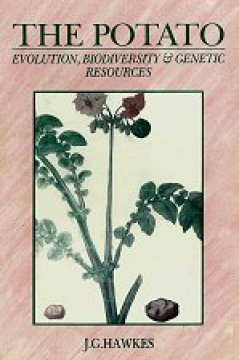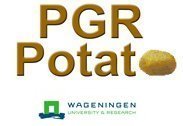
Article
Origin and taxonomy of potato
Origin
The potato was domesticated around Lake Titicaca from a diploid species belonging to the brevicaule group (in the wide sense; Spooner et al. 2005). More precise: Solanum candolleanum, a merger of a group of closely related species that occur North of lake Titicaca, whereas S. brevicaule became the merger of a group of related species occurring South of the lake. Oldest traces of potato tubers are about 7000 years old (Hawkes 1990). Most of the current landraces in Latin America are tetraploid and adapted to short days (group Andigenum). The diploid cultivated species Solanum phureja is well known for its lack of tuber dormancy (Ghislain et al, 2006). In Chile, long day adapted landraces are being cultivated (group Chilotanum). The Andigenum germplasm dominated in early European varieties. The Chilean potato became predominant after its introduction in 1811, because it was long day adapted (Ames & Spooner 2008; Gutaker et al. 2019). Adaptation under long-day conditions, superficial eyes, oblong tubers are present mainly in the Chilotanum germplasm and rarely in the Andigenum germplasm (Ghislain et al, 2009).
Taxonomy

Potato belongs to the family Solanaceae, genus Solanum, subgenus Potatoe, section Petota. Taxonomists (e.g. Ochoa, Hawkes and Bukasov) disagree on several points (Spooner & van den Berg, 1992). For an extensive literature review on potato systematics see Spooner & Hijmans (2001) and van den Berg & Groendijk-Wilders (2014). The most used scheme of potato nomenclature, dividing 232 species over 19 series is from Hawkes (1990). Examples of past confusion are S. bukasovii and S. multidissectum or S. brachycarpum and S. iopetalum. So genebanks may use different species names for the same sample.
Spooner and colleagues revised the classic potato nomenclature, based on extensive morphological analysis and molecular studies, first slow, more recent in big steps. An incomplete summary of the developments: Solanum palustre and S. brevidens are considered to be the same (Contreras & Spooner, 1999) and the earlier name (S. palustre) has to be used according to rules of taxonomic nomenclature. S. toralapanum became a subspecies of S. megistacrolobum (Giannattasio & Spooner 1994a, 1994b). The two subspecies of S. microdontum (subsp. microdontum and subsp. gigantophyllum) were synonymized (van den Berg & Spooner, 1992). S. astleyi became a subspecies of S. boliviense (Spooner et al., 1997). S. canasense was synonymised with S. bukasovii (Ochoa 1992) and later together with 40 other taxa merged into S. candolleanum (Spooner & Salas 2006; Spooner et al. 2014). S. fendleri, S. leptosepalum, S. papita and S. polytrichon were synonymized with S. stoloniferum (Spooner et al., 2004). S. tarijense was synonymised with S. berthaultii (Spooner et al., 2007). Furthermore, 32 taxa were considered to belong to a polymorphic group called the brevicaule group and synonymised (Spooner et al. 2014).
Ghislain et al. (2006) showed the diploid cultivated species S. phureja to be indefinable as traditionally recognized (diploid, no tuber dormancy), because 31% of the phureja accessions (at CIP) were tetraploid. Spooner et al. (2007) showed many accessions of S. phureja to cluster with the tetraploids and merged S. phureja and S. stenotomum with S. tuberosum subsp. andigena. Might the tetraploid phureja accessions have been misclassifications? Anyway, all phureja accessions at CGN were found to be diploid. Also the merger of S. megistacrolobum with S. boliviense is under dispute (Jacobs et al. 2011; van den Berg & Groendijk-Wilders 2014). The extensive SNP study of Hardigan et al. (2015) shows that the former S. megistacrolobum accession (PI 265873) does not cluster at all with two S. boliviense accessions, "suggesting possible errors in classification".
The recent status of Solanum species (incl. synonyms) is provided by GRIN taxonomy (search for Solanum), which also includes tomato and eggplant. The potato part has been published by Spooner et al. (2014), reducing the number of wild & cultivated potato species from 225 & 7 (Hawkes, 1990) to 107 & 4. This is the latest comprehensive taxonomic treatment of section Petota. Spooner et al. (2018) provide a reduced phlogenetic structure, comparing 131 diploid accessions.
Pictures are available at CGN at the accession level and a representative one is selected for the species level. CGN has not (yet) adopted the changes for the brevicaule, candolleanum and some other groups. Genebanks are traditionally conservative and reluctant in adopting changes in the nomenclature.
Potato taxonomists
Articles from Michael Jackson on potato taxonomists: "How long is a piece of string?" (20180109), "The humble spud" (20150226) and "Potatoes - the real treasure of the Incas" (20120218).
List of potato taxonomic monographs.
References
- Ames M. and D.M. Spooner (2008) DNA from herbarium specimens settles a controversy about origins of the European potato. Am J Bot 95:252–257.
- Berg, R.G. van den and N. Groendijk-Wilders (2014) Chapter 2: Taxonomy. In: R. Navarre & M. Pavek (eds.) The Potato: Botany, Production and Uses. CABI: 12-28.
- Berg, R.G. van den and D.M. Spooner (1992) A reexamination of infraspecific taxa of a wild potato, Solanum microdontum Bitter (Solanum sect. Petota: Solanaceae). Plant Systematics and Evolution 182: 239-252. doi:10.1007/BF00939190
- Contreras-M. A. & D.M. Spooner (1999) Revision of Solanum section Etuberosum (subgenus Potatoe). In: M. Nee, D.E. Symon, J.P. Jessop (eds.). Solanaceae IV: taxonomy, chemistry, evolution. pp. 227-245. Royal Botanic Gardens, Kew.
- Ghislain, M., D. Andrade, F. Rodríguez, R.J. Hijmans and D.M. Spooner (2006) Genetic analysis of the cultivated potato Solanum tuberosum L. Phureja Group using RAPDs and nuclear SSRs. Theor Appl Genet 113:1515–1527. doi:10.1007/s00122-006-0399-7
- Ghislain, M., J. Núñez, M. del Rosario Herrera and D.M. Spooner (2009) The single Andigenum origin of Neo-Tuberosum potato materials is not supported by microsatellite and plastid marker analyses. Theor Appl Genet 118:963–969. doi:10.1007/s00122-008-0953-6
- Giannattasio, R. & D.M. Spooner (1994a) A reexamination of species boundaries between Solanum megistacrolobum and S. toralapanum (Solanum sect. Petota, series Megistacroloba): morphological data. Systematic Botany 19: 89-105.
- Giannattasio, R. & D.M. Spooner (1994b) A reexamination of species boundaries and hypotheses of hybridization concerning Solanum megistacrolobum and S. toralapanum (Solanum sect. Petota, series Megistacroloba): molecular data. Systematic Botany 19: 106-115.
- Gutaker R.M., C.L. Weiß, D. Ellis, N.L. Anglin, S. Knapp, J.L. Fernández-Alonso, S. Prat and H.A. Burbano (2019) The origins and adaptation of European potatoes reconstructed from historical genomes. Nat. Ecol. Evol. 1093–1101. doi:10.1038/s41559-019-0921-3
- Hardigan, M.A., J. Bamberg, C.R. Buell and D.S. Douches (2015) Taxonomy and genetic differentiation among wild and cultivated germplasm of Solanum sect. Petota. Plant Genome 8(1):1-16.
- Hawkes, J.G. (1990) The Potato: evolution, biodiversity & genetic resources. Belhaven Press London. 259 pp.
- Jacobs, M.M.J., M.J.M. Smulders, R.G. van den Berg and B. Vosman (2011) What’s in a name; Genetic structure in Solanum section Petota studied using population-genetic tools. BMC Evolutionary Biology 11:42 . doi:10.1186/1471-2148-11-42
- Ochoa, C.M. (1992). New synonyms in the tuber-bearing Solanum. Phytologia 73: 166–168.
- Spooner, D.M. and R.G. van den Berg (1992) An analysis of recent taxonomic concepts in wild potatoes (Solanum sect. Petota). Genetic Resources and Crop Evolution 39: 23-37. doi:10.1007/BF00052651
- Spooner, D.M., R.G. van den Berg, A. Rodríguez, J. Bamberg, R.J. Hijmans & S.I. Lara Cabrera, 2004. Wild potatoes (Solanum section Petota; Solanaceae) of North and Central America. Systematic Botany Monographs volume 68. 209 pp.
- Spooner, D.M., D. Fajardo & G.J. Bryan (2007). Species limits of Solanum berthaultii Hawkes and S. tarijense Hawkes and the implications for species boundaries in Solanum sect. Petota. Taxon 56: 987-999.
- Spooner, D.M., M. Ghislain, R. Simon, S.H. Jansky and T. Gavrilenko (2014) Systematics, diversity, genetics, and evolution of wild and cultivated potatoes. Bot. Rev. 80:283-383. doi:10.1007/s12229-014-9146-y
- Spooner, D.M. and R.J. Hijmans (2001) Potato Systematics and Germplasm Collecting, 1989-2000. Amer J Potato Res 78:237–268.
- Spooner, D.M., K. McLean, G. Ramsay, R. Waugh and G.J. Bryan (2005) A single domestication for potato based on multilocus amplified fragment length polymorphism genotyping. PNAS 102:14694-14699. doi:10.1073/pnas.0507400102
- Spooner, D.M., J. Núñez, G. Trujillo, M. del Rosario Herrera, F. Guzmán and M. Ghislain (2007) Extensive SSR genotyping of potato landraces supports a major revaluation of their gene pool structure and classification. Proc Natl Acad Sci USA 104:19398-19403.
- Spooner, D.M., H. Ruess, C.I. Arbizu, F. Rodríguez and C. Solís-Lemus (2018) Greatly reduced phylogenetic structure in the cultivated potato clade (Solanum sect. Petota pro parte). Am. J. of Botany 0(0): 1–11. doi:10.1002/ajb2.1008
- Spooner, D.M. and A. Salas (2006) Structure, Biosystematics and Genetic Resources. In: J. Gopal and S. M. P. Khurana (eds) Handbook of potato production, improvement, and post-harvest management. Binghampton, New York: Haworth’s Press, Inc., pp 1–39. doi:10.1300/5776_01
- Spooner, D.M., M.L. Ugarte and P.W. Skroch (1997) Species boundaries and interrelationships of two closely related sympatric diploid wild potato species, Solanum astleyi and S. boliviense, based on RAPDs. Theor. Appl. Genet. 95: 764-771. doi:10.1007/s001220050623
